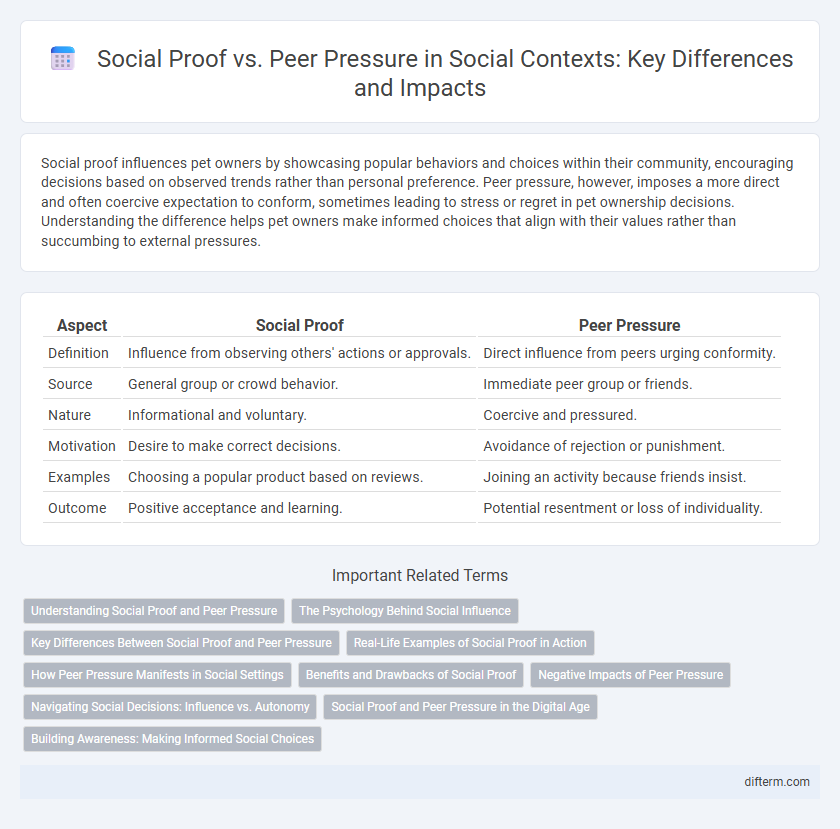Social proof influences pet owners by showcasing popular behaviors and choices within their community, encouraging decisions based on observed trends rather than personal preference. Peer pressure, however, imposes a more direct and often coercive expectation to conform, sometimes leading to stress or regret in pet ownership decisions. Understanding the difference helps pet owners make informed choices that align with their values rather than succumbing to external pressures.
Table of Comparison
| Aspect | Social Proof | Peer Pressure |
|---|---|---|
| Definition | Influence from observing others' actions or approvals. | Direct influence from peers urging conformity. |
| Source | General group or crowd behavior. | Immediate peer group or friends. |
| Nature | Informational and voluntary. | Coercive and pressured. |
| Motivation | Desire to make correct decisions. | Avoidance of rejection or punishment. |
| Examples | Choosing a popular product based on reviews. | Joining an activity because friends insist. |
| Outcome | Positive acceptance and learning. | Potential resentment or loss of individuality. |
Understanding Social Proof and Peer Pressure
Social proof refers to the psychological phenomenon where people imitate the actions of others in an attempt to reflect correct behavior in a given situation, often driven by the desire for social acceptance. Peer pressure involves social influence exerted by peers, compelling individuals to conform to group norms, sometimes leading to negative or risky behaviors. Recognizing the distinction between social proof as a guide for decision-making and peer pressure as coercive influence helps in navigating social dynamics effectively.
The Psychology Behind Social Influence
Social proof leverages the human brain's natural tendency to conform by observing others' behaviors, reinforcing trust and acceptance through perceived consensus. Peer pressure exerts direct social influence by compelling individuals to conform to group norms to avoid rejection or gain approval. Understanding the underlying psychological mechanisms reveals how social validation and fear of social exclusion drive decision-making and behavior modification.
Key Differences Between Social Proof and Peer Pressure
Social proof involves individuals adopting behaviors based on observing others in a group as a way to make informed decisions, emphasizing voluntary and positive influence. Peer pressure exerts compulsion through explicit or implicit demands from peers, often leading to conformity that may against personal values. The key difference lies in social proof promoting adaptive learning and peer pressure enforcing conformity through social coercion.
Real-Life Examples of Social Proof in Action
People often choose restaurants based on crowded venues, illustrating social proof as they assume popularity equals quality. Retailers boost sales by displaying best-sellers prominently, leveraging social proof to influence buying decisions. Online platforms use user ratings and reviews extensively, showing how social proof guides consumer trust and behavior in digital environments.
How Peer Pressure Manifests in Social Settings
Peer pressure manifests in social settings through implicit expectations and direct influence from peers to conform to group behaviors, decisions, or norms. It often leads individuals to adopt attitudes, engage in activities, or make choices they might otherwise avoid to gain acceptance or avoid rejection. This dynamic differs from social proof, which relies more on observed behaviors rather than explicit social demands.
Benefits and Drawbacks of Social Proof
Social proof leverages the influence of majority behavior to encourage positive actions, enhancing trust and decision-making efficiency in social and marketing contexts. It can increase conformity to beneficial norms but may also suppress individuality and propagate misinformation if the majority's behavior is misguided. Understanding the dynamics of social proof helps in designing campaigns that maximize its benefits while minimizing potential drawbacks like herd mentality.
Negative Impacts of Peer Pressure
Peer pressure often leads to negative behaviors such as substance abuse, academic cheating, and risky decision-making, as individuals prioritize group acceptance over personal values. Unlike social proof, which involves conformity based on legitimate cues, peer pressure exerts coercion that can damage mental health and self-esteem. This toxic influence increases vulnerability to anxiety, depression, and long-term social isolation.
Navigating Social Decisions: Influence vs. Autonomy
Social proof leverages observed behaviors from groups to guide decisions, often enhancing confidence by validating choices through collective endorsement. Peer pressure exerts direct influence, potentially compromising individual autonomy by compelling conformity through explicit or implicit demands. Navigating social decisions requires discerning when to embrace collective insights for informed judgment and when to assert personal values to maintain genuine independence.
Social Proof and Peer Pressure in the Digital Age
Social proof in the digital age leverages online reviews, influencer endorsements, and user-generated content to shape consumer behavior and enhance brand credibility. Peer pressure manifests through social media platforms where the desire for acceptance and validation drives individuals to conform to trends and opinions. Both social proof and peer pressure influence decision-making processes by amplifying social validation in virtual communities.
Building Awareness: Making Informed Social Choices
Social proof guides individuals to make informed social choices by highlighting positive examples and consensus within groups, reinforcing confidence in decisions. Peer pressure often imposes conformity through direct or indirect coercion, which can undermine personal values and awareness. Developing awareness about these dynamics enables individuals to distinguish between authentic social influence and manipulative pressure, fostering more autonomous and ethical interactions.
social proof vs peer pressure Infographic

 difterm.com
difterm.com